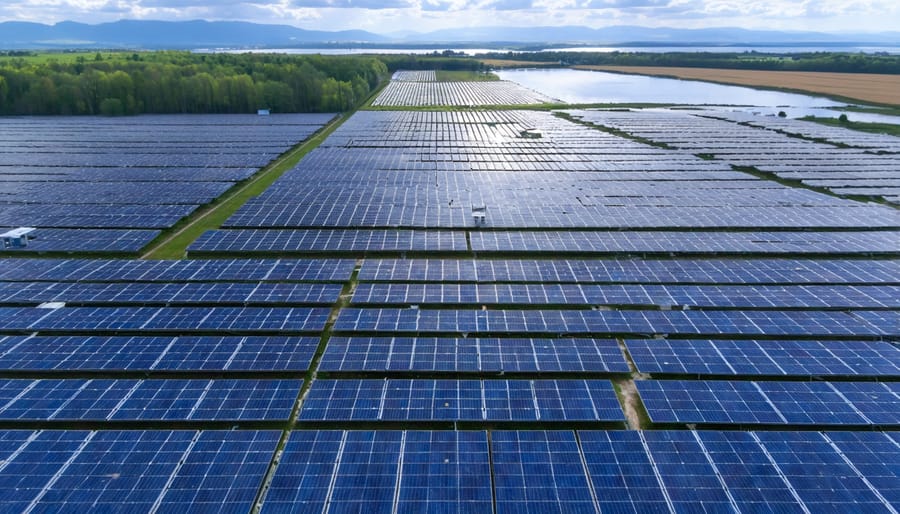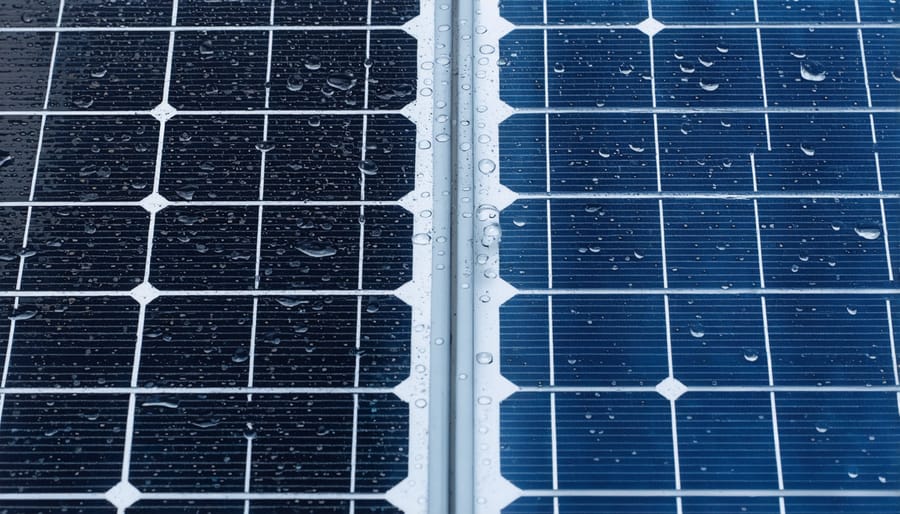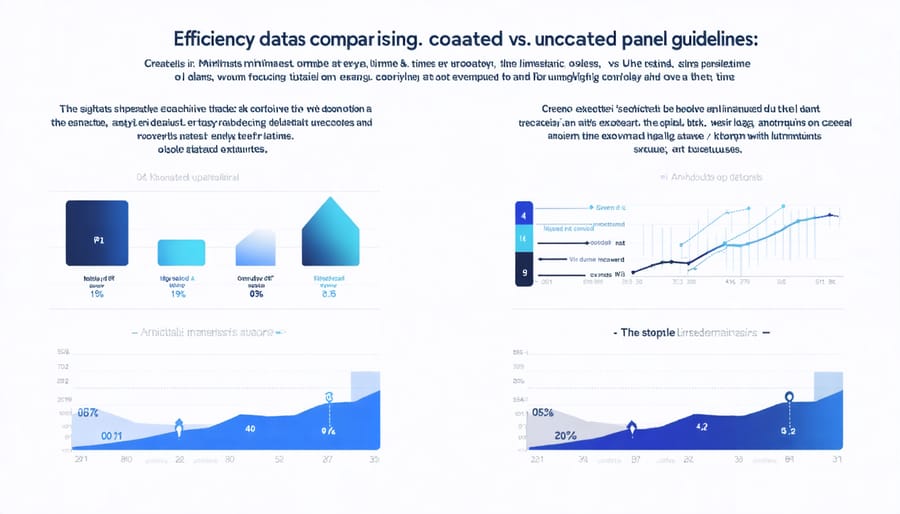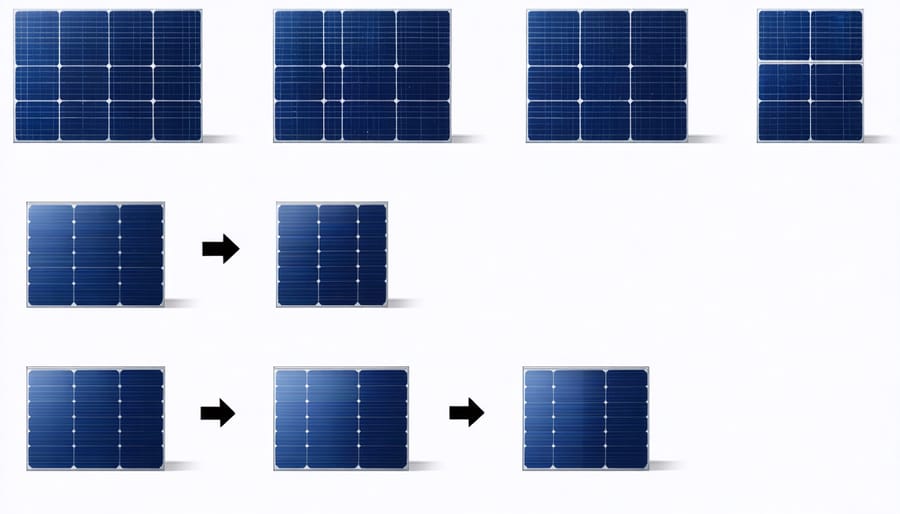Self-Cleaning Solar Panels: How Hydrophobic Coating Boosts Your Energy Output

Transforming solar panel efficiency begins with revolutionary hydrophobic coatings, a self-cleaning technology that’s reshaping renewable energy across Europe. These ultra-thin, water-repelling layers create a microscopic barrier that prevents dust, dirt, and water droplets from adhering to panel surfaces, maintaining optimal energy generation even in challenging weather conditions.
For European solar installations, where varying climates from Mediterranean coastal regions to Alpine environments pose unique maintenance challenges, hydrophobic coatings offer a compelling solution. By reducing cleaning frequency by up to 90% and increasing energy yield by 3-5%, these advanced materials directly address the performance concerns that often impact solar investments.
Recent innovations in nanotech-based hydrophobic treatments have made this technology more accessible and durable than ever before. With lifespans exceeding 10 years and application processes that integrate seamlessly into existing maintenance schedules, these coatings represent a strategic enhancement for both residential and commercial solar installations, ensuring maximum return on renewable energy investments while supporting Europe’s sustainable energy goals.
The Science Behind Hydrophobic Solar Panel Coatings
How Hydrophobic Coatings Work
Hydrophobic coatings create an ultra-thin protective layer on solar panels by utilizing advanced nano-materials that repel water through a phenomenon known as the lotus effect. These coatings feature microscopic structures that create a surface tension so high that water droplets maintain their spherical shape instead of spreading across the panel.
When water hits a hydrophobic-coated surface, it forms nearly perfect spheres with contact angles greater than 150 degrees. These water droplets then roll off easily, carrying dust, dirt, and other contaminants with them. This self-cleaning mechanism works because the water droplets have stronger adhesion to the dirt particles than the coated panel surface has to either.
The coating’s molecular structure typically consists of fluorinated or silicone-based compounds that create a microscopic pattern of peaks and valleys. This structure traps a thin layer of air beneath water droplets, preventing them from making full contact with the panel’s surface. The result is an efficient self-cleaning process that maintains the panel’s light transmission capabilities and ensures optimal energy generation, even in challenging weather conditions.

Types of Hydrophobic Coatings
Several innovative advanced solar panel coatings are available in today’s market, each offering unique benefits for solar installations. Fluoropolymer-based coatings represent one of the most widely adopted solutions, providing excellent water repellency and durability in diverse weather conditions. These coatings create a microscopic texture that causes water droplets to roll off easily, carrying dust and debris with them.
Nano-ceramic coatings offer another cutting-edge solution, utilizing silicon dioxide (SiO2) technology to create an invisible protective layer that bonds at the molecular level with the panel surface. This technology provides superior scratch resistance and long-term protection against environmental factors.
Self-cleaning crystalline coatings have gained popularity in European markets, particularly in regions with high pollution levels. These coatings use photocatalytic properties to break down organic matter when exposed to sunlight, maintaining panel cleanliness with minimal maintenance.
Silicon-based hydrophobic treatments offer a cost-effective alternative, though they typically require more frequent reapplication compared to other options. These treatments are particularly suitable for residential installations and smaller commercial projects where budget considerations are paramount.
Performance Benefits for Solar Installations
Energy Output Enhancement
Recent studies across European solar installations demonstrate significant improvements in energy output when hydrophobic coatings are properly applied. Field tests conducted in regions with varied weather conditions show that coated panels consistently outperform untreated installations by 3-7% annually. This enhancement is particularly notable during autumn and winter months, where energy production typically experiences seasonal decline.
In controlled experiments across multiple European test sites, hydrophobic-coated panels maintained up to 98% of their optimal performance even after extended exposure to dust, pollen, and industrial pollutants. Uncoated panels, by comparison, showed degradation of up to 15% under similar conditions before cleaning.
The efficiency gains are most pronounced in urban and industrial areas, where atmospheric pollution poses significant challenges. Data collected from installations in major European cities indicates that hydrophobic-coated panels require 70% fewer cleaning interventions while maintaining peak performance levels. This translates to approximately 85-120 additional kilowatt-hours per year for a typical 5kW residential system.
For commercial installations, the impact is even more substantial. Large-scale solar farms equipped with hydrophobic coatings have reported average annual output increases of 5.2%, with some locations achieving improvements of up to 8.3% during periods of heavy rainfall or snowfall. These improvements in energy yield directly contribute to faster return on investment and increased system reliability.

Maintenance Cost Savings
The application of hydrophobic coatings on solar panels delivers significant maintenance cost savings through multiple channels. Traditional solar panel cleaning typically requires regular professional services, specialized equipment, and considerable water usage. However, panels treated with hydrophobic coating dramatically reduce these requirements, with many installations requiring only 2-3 cleanings per year instead of monthly maintenance.
The self-cleaning properties of hydrophobic coatings enable rain to effectively wash away dust, bird droppings, and other debris. This natural cleaning process maintains optimal panel efficiency while reducing the need for manual intervention. For a typical 100kW commercial installation, this can translate to annual maintenance savings of €1,200 to €2,000.
Beyond direct cleaning costs, hydrophobic coatings extend the operational lifespan of solar panels by preventing mineral deposits and environmental degradation. The protective layer shields the panel surface from harsh weather conditions, reducing micro-scratches and wear that could otherwise compromise performance over time.
For businesses and homeowners, the long-term financial benefits are compelling. A single application of hydrophobic coating can maintain its effectiveness for 5-7 years, providing sustained protection and reduced maintenance needs. When factoring in reduced water consumption, lower labour costs, and decreased equipment wear, the return on investment typically materializes within 18-24 months of application.
European Climate Considerations
Europe’s diverse climate presents unique challenges for solar energy systems, making hydrophobic coatings particularly valuable across the continent. From the frequent rainfall in the British Isles to heavy snowfall in the Alps and intense Mediterranean dust storms, these environmental factors significantly impact solar panel performance in various weather conditions.
In Northern European regions, where rainfall is prevalent throughout the year, hydrophobic coatings help maintain consistent energy production by enabling water to slide off panels efficiently. This self-cleaning effect is particularly beneficial during autumn and winter months when maintenance access might be limited due to weather conditions.
Central European installations benefit from enhanced snow management capabilities. The coating’s low surface tension helps prevent snow accumulation and accelerates melting, reducing system downtime during cold seasons. This feature is especially valuable in alpine regions and areas experiencing regular snowfall.
For Southern European installations, the coating provides crucial protection against dust and sand particles common in Mediterranean climates. This is particularly relevant for coastal areas where salt spray can compromise panel efficiency, and in regions affected by Saharan dust events.
The coating’s durability is specifically tested against European weather extremes, from freeze-thaw cycles in Scandinavia to intense UV exposure in southern regions. This comprehensive weather resistance makes it an ideal solution for long-term installation protection across all European climate zones, helping maintain optimal energy generation throughout the system’s lifetime.
Installation and Durability
Application Process
The application of hydrophobic coating to solar panels follows a systematic process that ensures optimal performance and longevity. First, the panels must be thoroughly cleaned using specialized solar panel cleaning solutions to remove all dirt, debris, and existing residue. This preparation stage is crucial for proper coating adhesion.
Once cleaned, the panels must be completely dry before application can begin. The coating is typically applied using a microfibre applicator or specialized spray equipment, depending on the specific product being used. Technicians work in small sections, applying an even layer of the hydrophobic solution across the panel surface.
Most professional-grade coatings require a curing period of 24-48 hours under dry conditions. During this time, the panels should not be exposed to rain or excessive moisture. Some advanced formulations feature a dual-layer system, where a base coat is applied first, followed by a top coat after initial curing.
For optimal results, installation should be carried out by certified professionals who understand the specific requirements of different coating products and panel types. Regular maintenance inspections are recommended to ensure the coating continues to perform effectively.

Long-term Performance
High-quality hydrophobic coatings demonstrate remarkable durability, typically maintaining their effectiveness for 5-7 years under normal environmental conditions. This extended performance contributes significantly to overall solar panel longevity, reducing the need for frequent reapplication and maintenance.
The coating’s performance gradually diminishes over time due to environmental factors such as UV exposure, extreme weather conditions, and mechanical stress. However, proper initial application and routine inspection can help maximize its protective capabilities. Most manufacturers recommend annual inspections to assess coating integrity and effectiveness.
Maintenance requirements are minimal compared to uncoated panels. A gentle water rinse every 6-12 months is typically sufficient to remove any accumulated debris. Should the coating show signs of degradation, spot treatments can be applied to affected areas, eliminating the need for complete reapplication.
For optimal long-term performance, it’s advisable to document the initial application date and maintain a regular inspection schedule. This proactive approach ensures the coating continues to deliver its water-repelling and self-cleaning benefits throughout its service life.
Hydrophobic coating technology represents a significant leap forward in solar panel efficiency and maintenance. By implementing this innovative solution, European property owners and businesses can expect increased energy production, reduced cleaning frequency, and extended panel lifespan. The self-cleaning properties not only ensure optimal performance throughout the year but also contribute to significant cost savings in maintenance and operations. As Europe continues its transition towards sustainable energy solutions, the adoption of hydrophobic coatings emerges as a practical and effective way to maximize solar investment returns. With proven results in various climatic conditions across the continent, this technology stands as a testament to how innovative surface treatments can enhance renewable energy systems. We encourage solar panel owners to consider this sustainable solution for their installations, ensuring better performance and reliability in their clean energy journey.
Leave a Reply